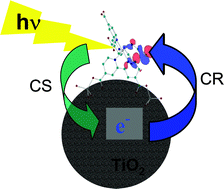Photochemical approaches to solar energy conversion are currently making rapid progress, increasing not only academic but also commercial interest in molecular-based photovoltaic solar cells. This progress has been achieved not only by increased understanding of the physics and physical chemistry of device function but also through advances in chemical and materials synthesis and processing, which now allows the design and fabrication of increasingly sophisticated device structures organised on the nanometer length scale. In this feature article, we review some progress in this field, focusing in particular upon the electron-transfer dynamics which underlie the function of dye-sensitised, nanocrystalline solar cells. The article starts by building upon the parallels between the function of such devices and the function of simple donor/acceptor molecular systems in solution. We then go on to discuss the optimisation of device function, and in particular the use of self-assembly-based strategies to control interfacial electron-transfer kinetics.
